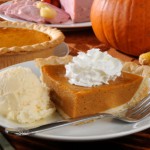Worried about overeating high-calorie goodies during the upcoming holidays and piling on the pounds? Eating foods with a higher percent of calories from protein may be all it takes to help control appetite and manage weight, a new study suggests.
Researchers from the University of Sydney in Australia, Cambridge University in the United Kingdom, and Massey University in New Zealand found that lean adult men and women fed foods containing 15 or 25 percent calories from protein over a four-day period ate 12 percent fewer calories overall than subjects fed foods containing 10 percent calories from protein.
The study, published in PLoS One in October, also found that the subjects fed the lower protein (10 percent) diet reported they were hungrier after breakfast in comparison to those fed a higher (25 percent) protein diet.
“In our study population a change in the nutritional environment that dilutes dietary protein with carbohydrate and fat promotes overconsumption, enhancing the risk for potential weight gain,” the authors wrote.
“Protein Leverage Theory”
When placing blame on contributors to the increasing obesity epidemic in the United States, the usual suspects that come to mind are easy access to high-calorie foods and too little time spent exercising. This study was designed to test a “protein leverage theory”, which proposes that when faced with a diet lacking enough protein—a more hunger-satisfying nutrient— people compensate by overeating.
The protein leverage theory is not far-fetched—studies in other species including non-human primates, pigs, rodents, birds, fish, and insects all consistently show that when the percentage of protein is reduced in their diets, they compensate by eating more calories from non-protein sources such as carbohydrate and fats.
Between 1961 and 2000, the protein percentage in Americans’ diets declined from 14 percent to 12.5 percent. Although it’s less than a 2 percent drop, it was paired alongside a 14 percent increase in total caloric intake from fat and carbohydrate.
Study Design
Twenty two healthy, lean men and women participated in three, four-day study sessions where the subjects stayed overnight and had all meals provided and their eating habits monitored.
The recipes for the foods made were modified to contain 10, 15, or 25 percent calories from protein. Fat was kept constant at 30 percent, and carbohydrate was also modified to be 60, 55, or 45 percent of calories. The study’s meals were prepared in a way so the participants could not tell the difference in the fat, carbohydrate, or protein content of the foods eaten. Meals served included apricot yogurt muesli for breakfast, teriyaki sushi roll for lunch, and chow mein for dinner. Outside of meals, snack foods, or ‘anytime foods’, were also available to the participants whenever they liked, and these were either sweet or savory options—carrot cake, apple crumble muffins, and cheese scones among the choices.
When comparing what subjects ate on the 10 percent protein diet versus the 15 percent protein diet, researchers found that subjects consumed an average of 12 percent more calories over the 4-day session. Of that 12 percent increase, 57 percent was due to eating more savory foods, and 43 percent due to eating more sweet foods.
The authors noted that 70 percent of the caloric increase in the subjects on the 10 percent protein diet came from eating foods that were available anytime (snack foods). The increase in calories was evident from the first day of the trials and persisted throughout.
“If subjects maintained the level of increased intake observed on the 10 percent protein diet in our study,
without an accompanying increase in energy expenditure through increased activity,” the authors wrote, “a 1.0 kg [about 2 pounds] weight increase per month would be expected.”
IsaLean Shake and IsaPro
One convenient way to obtain hunger-satisfying protein is IsaLean Shake. The complete meal replacement contains only 240 calories, of which more than 35 percent comes from high-quality protein.
The high-protein shake is clinically shown to promote healthy weight loss, help maintain or build muscle when combined with exercise, and help maintain healthy blood sugar levels.
Vanilla IsaPro whey protein is another product that can be enjoyed by adding one scoop to one and a half scoops of IsaLean Shake, or mixed into recipes (like this one). Whey protein is ideal for boosting fat burning and promoting muscle maintenance.
Reference: Gosby AK, Conigrave AD, Lau NS et al. Testing protein leverage in lean humans: a randomised controlled experimental study. PLoS One 2011;6:e25929. doi: 10.1371/journal.pone.0025929

No comments:
Post a Comment